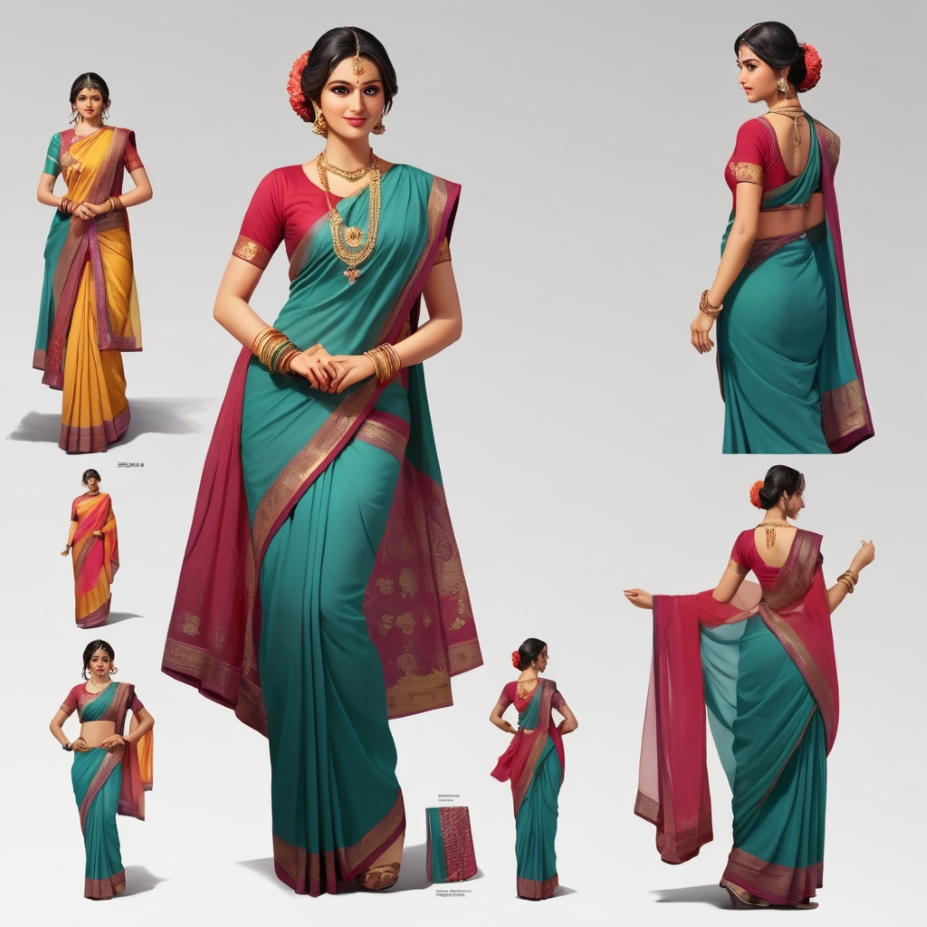
Saree, a timeless symbol of grace and elegance, is more than just a garment—it is a piece of culture and tradition, passed down through generations. The beauty of a saree lies in its versatility and the countless ways it can be draped to suit different occasions, body types, and personal styles. Let’s explore some popular saree draping styles, from classic to contemporary, that you can try to enhance your wardrobe and style quotient.
1. The Nivi Style (Classic Indian Style)
The Nivi drape is the most traditional and widely worn style of saree draping, originating from Andhra Pradesh. This style is simple, elegant, and perfect for both formal and casual events.
How to drape:
- Start by tucking one end of the saree into the petticoat.
- Wrap the saree around your waist once, keeping it snug.
- Make pleats at the center (about 6–7 pleats), tuck them into the petticoat, and let the pleats fall evenly.
- The pallu (the loose end of the saree) is draped over the left shoulder in a neat pleated or free-flowing manner.
This style is ideal for any occasion and suits all body types. It can be worn with a variety of blouse designs, from sleeveless to full-sleeve, depending on the occasion.
2. Bengali Style
This unique and striking style comes from the cultural heartland of Bengal. It has a distinctive, almost royal look, perfect for festive occasions like Durga Puja and weddings.
How to drape:
- Instead of pleating the saree, wrap it around the waist.
- The pallu is taken from the back to the front over the right shoulder and then brought around to the left shoulder, often with a bunch of keys or other accessories tied to it.
- The pallu usually has large pleats, and the border of the saree is emphasized for a traditional touch.
This drape style works best with heavier, intricately designed sarees, such as Banarasi silk or Jamdani sarees.
3. Maharashtrian Nauvari Style
The Nauvari saree is draped in a unique way that resembles a dhoti. Traditionally worn by women in Maharashtra, this drape is perfect for special cultural events or dance performances, giving a regal and traditional look.
How to drape:
- Take a nine-yard saree (longer than a regular saree).
- The saree is tucked at the back and draped between the legs like a dhoti.
- The pallu is draped over the shoulder or can be tucked into the waist.
This style is perfect for athletic or festive events and offers comfort while maintaining a traditional appearance.
4. Gujarati Style (Seedha Pallu)
The Gujarati draping style is characterized by its pallu from the back to the front. This style is ideal for festive occasions like Navratri and weddings.
How to drape:
- Start with a simple wrap around the waist.
- Make pleats at the center, tuck them in, and bring the pallu from the back over the right shoulder.
- Spread the pallu in front, pinning it neatly.
This eye-catching style showcases the pallu and its intricate designs, making it ideal for sarees with heavy embroidery or detailed borders.
5. Lehenga Style Drape
This modern, stylish twist on traditional draping creates the illusion of a lehenga while using a saree. It’s a trendy option for weddings, receptions, or other high-fashion events.
How to drape:
- Start by making multiple small pleats and tucking them around the waist, like a lehenga.
- Drape the pallu in pleats over one shoulder or let it flow freely.
This style works best with sarees that have heavy embroidery, lace, or embellishments and creates a fusion look that blends traditional saree draping with the elegance of a lehenga.
6. Belt Style Drape
Adding a belt to the saree is a modern twist that has gained popularity in recent years. It cinches the waist, adding structure and style to the traditional saree drape.
How to drape:
- Drape the saree in the Nivi style.
- Add a belt over the pleats, just above the navel, to accentuate your waistline.
This style is a great choice for modern brides or anyone looking to combine traditional and contemporary fashion elements.
7. Pant Style Drape
The pant-style drape is one of the most contemporary and fashion-forward ways to wear a saree, giving it an edgy, chic look. This is perfect for fusion events or when you want to add a modern twist to traditional attire.
How to drape:
- Wear fitted pants or leggings instead of a petticoat (underskirt)
- Drape the saree in the usual way, but instead of making pleats at the waist, tuck it into the pants.
- Let the pallu fall over your shoulder in a sleek manner.
This style is comfortable, easy to manage, and perfect for fashion enthusiasts who love experimenting with their wardrobe.
8. Kerala Mundu Style
Originating from Kerala, the Mundu style is a simple yet elegant draping style, traditionally worn during festivals like Onam.
How to drape:
- The saree is wrapped around the waist and tucked in the front.
- The pallu is draped over the shoulder, without pleating.
This style is best for cotton or Kasavu sarees and offers a natural, minimalist look perfect for summer or cultural events.
Final Thoughts
The way a saree is draped can dramatically transform your appearance. Whether you’re going for a timeless traditional look or a contemporary fusion style, there’s a saree draping technique for every occasion, body type, and fashion preference. By experimenting with these styles, you can keep your saree game fresh, elegant, and always in style!
So, which saree draping style are you going to try next?
Leave a Reply